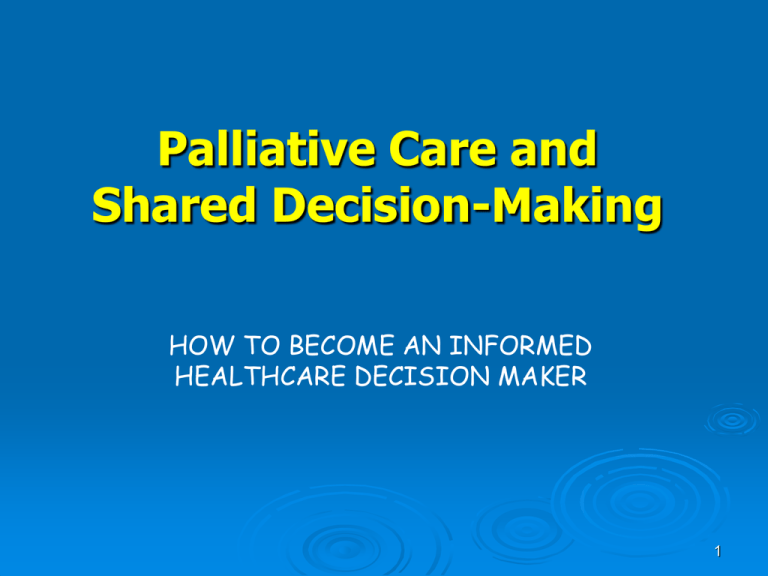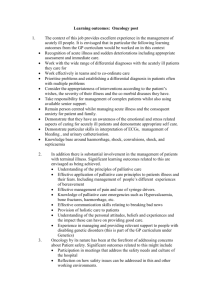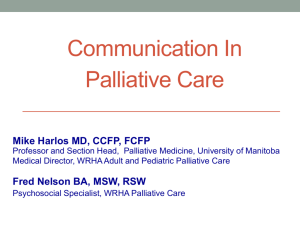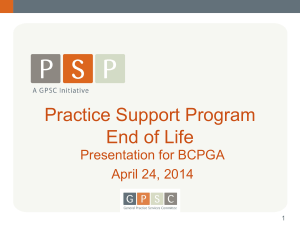Palliative Care and Shared Decision
advertisement

Palliative Care and Shared Decision-Making HOW TO BECOME AN INFORMED HEALTHCARE DECISION MAKER 1 Definitions “Palliative care is competent and compassionate care which provides coordinated medical, nursing and allied health services for people who are terminally ill, delivered where possible in the environment of the patient’s choice. It provides relief from pain and other distressing symptoms, integrates psychological and spiritual aspects of care, focuses on supporting patients to live as actively as possible until death, and includes grief and bereavement support for the patient, family and other care-givers during the life of the patient, and continues after the death of the patient.” – Traditional palliative care for end of life “Shared decision making is defined as decisions that are shared by doctors and patients, informed by the best evidence available and weighted according to the specific characteristics and values of the patient.” -Dartmouth Hitchcock Medical Center 2 Shared Decision Making Honors both the health care provider’s expert knowledge and the patient’s right to be fully informed of all care options and the potential harms and benefits. This process provides patients with the support they need to make the best individualized care decisions, while allowing providers to feel confident in the care they prescribe. 3 Shared Decision Making Informed Medical Decisions Foundation Partnerships for Quality Care www.informedmedicaldecisions.org This foundation works to advance shared decision making through research, policy, clinical models, and patient decision aids. High quality medical decisions are possible if the patient is fully informed and shares in the decision making. 4 Shared Decision Making Six Steps 1. 2. 3. 4. Invitation to the patient to participate Present options Provide information on benefits and risks Assist patient in evaluating options based on their goals 5. Facilitate deliberation and decision-making 6. Assist with implementation From the Informed Medical Decisions Foundation Shared Decision Making How to approach your provider Tips 1. 2. 3. 4. 5. 6. Explain why you want the visit when you schedule Don’t bring a laundry list of other problems Do some research before the visit (websites, etc) Think about your own goals and values Enter with an open mind; expect same from provider Don’t expect provider to do something inappropriate or against their own values Introduction to Illness Trajectories In Hippocrates' day, the physician who could fore-tell the course of the illness was most highly esteemed, even if he could not alter it. Today, physicians can cure some diseases and manage others effectively. Where we cannot alter the course of events we must at least (when the patient so wishes) predict sensitively and together plan care, for better or for worse. Predicting and planning is not just for the physician 7 Predicting Prognosis Whose responsibility is it? ePrognosis.org Journal of the American Medical Association article in January 10, 2012 included information about various prognostic tools and the association created a website for MDs and patients. It is easy to enter medical information into these tools and in a matter of minutes the calculator gives a probability of survival. Using ePrognosis effectively will take much more work before there is a number that is accurate for a patient. How the number should be applied to care is as much an art as a science. Illness Trajectories Information that helps guide care decisions What to ask your healthcare practitioner Typical illness trajectories for people with progressive chronic illness. Adapted from Lynn and Adamson, 2003. From the RAND Corporation, Santa Monica, California, USA 9 Three Typical Trajectories 10 Trajectory of Four Domains of Care Living Existing Limitations of Trajectories “One size may not fit all” Different models of care will be appropriate for people with different illness trajectories. Most people over 65 years old have average of 1.5 chronic diseases. 12 Palliative Care and Hospice Care Transitions There are few mechanisms in place to coordinate care across settings, and most often no single practitioner or team assumes responsibility during patient care transitions Begin planning for a transfer to the next care setting upon or before a patient’s admission. Elicit the preferences of patients and caregivers and incorporate these preferences into the care plan. 14 Major Issue for Care Transitions Why do hospitals have readmissions? Poor Provider-Patient interface, poor medication management, no effective patient engagement strategies, unreliable follow-up Unreliable system support Lack of standard and known processes Unreliable information transfer 1 in 5 Medicare patients re-hospitalized within 30 days of a hospital discharge Half of these occurred before the patient was seen by the outpatient healthcare provider Estimated cost 17.4 billion annually in US 15 Conversations at Care Transitions Shared Medical Decision making – time to talk about changes in goals or make different decisions Questions that you should be asked by your health care practitioner if you have a life-threatening illness – acute or chronic: 1. How much do you want to know about your prognosis? 2. What kind of information do you want to know about your prognosis? Statistics – time-frame, etc 3. You may hear the phrase…“if your time is short what would you like to have your treatment plan include?” 16 Questions? 17











